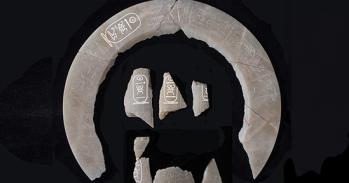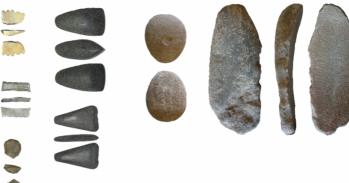Excavation of a site in the Cambridgeshire fens reveals a Bronze Age settlement with connections far beyond its watery location. Over the past ten months, Must Farm has yielded Britain’s largest collections of Bronze Age textiles, beads and domestic artefacts. Together with timbers of several roundhouses, the finds provide a stunning snapshot of a community thriving 3,000 years ago.
Excavation of a site in the Cambridgeshire fens reveals a Bronze Age settlement with connections far beyond its watery location. Over the past ten months, Must Farm has yielded Britain’s largest collections of Bronze Age textiles, beads and domestic artefacts. Together with timbers of several roundhouses, the finds provide a stunning snapshot of a community thriving 3,000 years ago.
Perhaps uniquely, we are seeing the whole repertoire of living at Must Farm – from food procurement to cooking, eating and waste and the construction and shaping of building materials.
Charles French
Archaeologists have made remarkable discoveries about everyday life in the Bronze Age during their ten-month excavation of 3,000-year-old circular wooden houses at Must Farm in Cambridgeshire, a site that has been described as the 'Pompeii of the fens'.
Believed to be the best-preserved Bronze Age dwellings ever found in Britain, the houses were destroyed by a fire that caused the settlement, which was built on stilts, to collapse into the shallow river beneath. The soft river silt encapsulated the remains of the charred dwellings and their contents, which survive in extraordinary detail.
The range and quality of the many finds have astonished members of Cambridge Archaeological Unit and colleagues at the McDonald Institute for Archaeological Research, Division of Archaeology. The fire is thought to have happened soon after the construction of the roundhouses.
“The excellent preservation of the site is due to deposition in a water-logged environment, the exclusion of air and the lack of disturbance to the site. The timber and artefacts fell into a partly infilled river channel where they were later buried by more than two metres of peat and silt,” said Professor Charles French from the Division of Archaeology. “Surface charring of the wood and other materials also helped to preserve them.”
Now the excavation is coming to an end, archaeologists are able to build a near complete picture of domestic life in a Bronze Age house: where activities happened, what the roof was made of, what people were wearing, and how their clothes were produced. The materials found provide evidence of farming, crafts and building technologies.
The site has revealed the largest collections in Britain of Bronze Age textiles, beads, domestic wooden artefacts (including buckets, platters, troughs, shafts and handles) and domestic metalwork (axes, sickles, hammers, spears, gouges, razors, knives and awls). It has also yielded a wide range of household items; among them are several complete ‘sets’ of storage jars, cups and bowls, some with grain and food residues still inside. Most of the pots are unbroken and are made in the same style; this too is unprecedented.
“Perhaps uniquely, we are seeing the whole repertoire of living at Must Farm – from food procurement to cooking, eating and waste and the construction and shaping of building materials,” said Professor French. “We see the full tool and weapons kits – not just items that had been lost, thrown away or deposited in an act of veneration – all in one place.”
Finds of textiles and fibres illuminate the stages of textile production, and include hanks of prepared fibre, thread wound on wooden sticks or into balls, and finished fabrics of various qualities. “The outstanding level of preservation means that we can use methods, such as scanning electron microscopy which magnifies more than 10,000 times, to look in detail at the fibre content and structure,” said Dr Margarita Gleba, an archaeologist specialising in textiles.
“All the textiles appear to have been made from plant fibres. The people at Must Farm used cultivated species, such as flax, as well as wild plants, such as nettle and perhaps trees, to obtain raw materials. Flax provided the finest fibres and was used to weave fine linen fabrics on a loom. The linen textiles found at Must Farm are among the finest from Bronze Age Europe. Wild fibres appear to have been used for coarser fabrics made in a different technique, known as twining.”
Two rare well-preserved Bronze Age tripartite wheels have been found on site. These attest to a world beyond the river and to the ongoing relationship between the wetland settlement and the adjacent managed and cultivated dry land. Despite the site’s situation in a wetland, the majority of the surviving material speaks of an economy based on dry land.
Several undergraduates on Cambridge’s archaeology course have had the chance to assist with the dig, working alongside Cambridge Archaeological Unit to gain first-hand experience of a water-logged site. Professor French said: “Four of our students were able to experience the challenge of digging organic remains in a matrix of organic silt – and dealing with the three-dimensional structures of the collapsed dwellings which require a particular way of thinking.”
Visits to the site by more than 2,000 members of the public have been led by Selina Davenport of Cambridge Archaeological Unit. “One of the things that people find most fascinating is the way in which the site questions the long-held view about life in the fens during the Bronze Age that communities used the resources of the watery environment but lived on dry land,” she said.
“The finds at Must Farm reveal that some communities were living right in the heart of the fen – and that these people were connected to others by an active thoroughfare which linked them to the rest of Britain and to the North Sea.”
The excavation is funded by Historic England and building products supplier Forterra. The work on the site has been carried out by the Cambridge Archaeological Unit. Further work on the finds is taking place at the McDonald Institute, Division of Archaeology, and other centres.
More images (courtesy of Historic England) of some of the finds.
Stuffocation in the Bronze Age
David Gibson, Archaeological Manager at the Cambridge Archaeological Unit, Division of Archaeology, University of Cambridge, said that the exceptional site of Must Farm gives a picture, in exquisite detail, of everyday life in the Bronze Age.
He said: "Domestic activity within structures is demonstrated from clothing to household objects, to furniture and diet. These dwellings have it all, the complete set, it’s a 'full house'. 'Stuffocation', very much in vogue in today’s 21st century, may, given the sheer quantity of finds from the houses at Must Farm, have been a much earlier problem then we’d ever imagined.”
What did people wear 3,000 years ago?
The community living in these roundhouses were making their own high quality textiles, like linen. Some of the woven linen fabrics are made with threads as thin as the diameter of a course human hair and are among the finest Bronze Age examples found in Europe.
Other fabrics and fibres found include balls of thread, twining, bundles of plant fibres and loom weights which were used to weave threads together. Textiles were common in the Bronze Age but it is very rare for them to survive today.
What did they eat?
Wild animal remains found in rubbish dumps outside the houses, show they were eating wild boar, red deer and freshwater fish such as pike. Inside the houses, the remains of young lambs and calves have been found, revealing a mixed diet. While it is common for Late Bronze Age settlements to include farm domestic animals, it is rare to find wild animals being an equally important part of their diet. Plants and cereals were also an important part of the Bronze Age diet and the charred remains of porridge type foods, emmer wheat and barley grains have been found preserved in amazing detail, sometimes still inside the bowls they were served in.
What household goods did they have?
Each of the houses was fully equipped with pots of different sizes, wooden buckets and platters, metal tools, saddle querns (stone tools for grinding grains), weapons, textiles, loom weights and glass beads. These finds suggest a materialism and sophistication never before seen in a British Bronze Age settlement. Even 3,000 years ago people seemed to have a lot of stuff.
Many of these objects are relatively pristine suggesting that they had only been used for a very short time before the settlement was engulfed by fire.
What did Bronze Age houses look like?
At least five houses have been found at the Must Farm settlement, each one built very closely together for a small community of people. Every house seems to have been planned in the same way, with an area for storing meat and another area for cooking or preparing food.
The roundhouses were built on stilts above a small river. The conical roofs were built of long wooden rafters covered in turf, clay and thatch. The floors and walls were made of wickerwork, held firmly in place by the wooden frame.
What were they trading in?
Some 18 pale green and turquoise glass beads have been found which analysis has shown were probably made in the Mediterranean basin or the Middle East.
The Q&A above is taken from a Historic England press release.

The text in this work is licensed under a Creative Commons Attribution 4.0 International License. For image use please see separate credits above.




